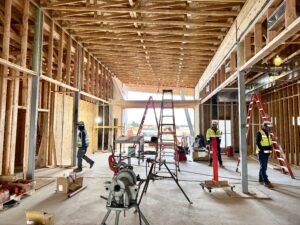The field of education is evolving rapidly. New research drives the development of innovative, science-based school design features. These features aim to improve learning environments for early childhood and K-12 education. From biophilic design to flexible learning spaces, these trends shape the future of educational architecture. They support cognitive, social, and emotional development.

Biophilic Design
Biophilic design integrates natural elements into the built environment, promoting well-being and cognitive function in children. Studies have shown that exposure to natural light, plants, and natural materials can reduce stress and improve attention spans in young learners (Harvard Health, 2020; ScienceDirect, 2019). For example, incorporating large windows, green walls, and outdoor learning spaces can foster a connection with nature, enhancing both physical and mental health. Mimicking biomorphic patterns and forms through architectural elements such as column and window placement, as well as implementing material connections to nature, can enhance cognitive performance (Browning et al., 2014).
Flexible Learning Spaces
Flexible learning spaces are another emerging trend, offering adaptability to various teaching methods and learning activities. These spaces often include movable furniture, modular walls, and multi-functional areas that can be easily reconfigured. This flexibility supports differentiated instruction, collaborative learning, and individual exploration, catering to the diverse needs of children (Edutopia, 2021).
Sensory Integration
Designing for sensory integration involves creating environments that engage all five senses, which is crucial for children’s development. Features such as textured surfaces, varied lighting, and acoustic treatments can help children process sensory information more effectively. Sensory-rich environments can support learning and behavior, especially for children with sensory processing disorders (Psychology Today, 2019).
Sustainable Materials
Using sustainable, non-toxic materials in education settings is vital for creating healthy indoor environments. Low-VOC paints, natural wood finishes, and hypoallergenic carpets can improve air quality and reduce health risks. Sustainable design not only promotes physical health but also teaches children the importance of environmental stewardship from a young age (USGBC, 2020).
Technology Integration
Integrating technology in education environments is becoming increasingly important. Interactive whiteboards, tablets, and educational software can enhance learning experiences, making them more engaging and interactive. However, it is crucial to balance technology use with traditional hands-on activities to support holistic development (NAEYC, 2018; Edutopia, 2022).
Community Engagement Spaces
Creating spaces that encourage community engagement is essential for all ages of education. Areas designed for parental involvement, community meetings, and collaborative projects can strengthen the relationship between the school and the broader community. These spaces can foster a sense of belonging and support the social development of children (Edutopia, 2020).
School Design for Therapy
Not only have new design trends emerged in the traditional school model, but innovative teaching pedagogies have also been adopted to merge the needs of childhood education with pediatric therapy and neurodivergence. EVstudio is excited to collaborate with several organizations in Colorado to incorporate programs such as occupational and speech therapy into classroom design. Key design elements include diverse wall surfaces and ample square footage to facilitate various therapeutic activities, along with a range of textures to encourage different types of movement such as sitting, standing, swinging, and climbing. Design features that ensure auditory privacy provide quiet, private areas conducive to therapy sessions, while dimmable, zoned lighting creates optimal environments for different activities and needs. Additionally, the strategic use of colors aids in wayfinding and enhances the school’s character (Barton, 2015). Patterns, braille, and changes in floor texture throughout the room assist individuals who are blind in navigating the space effectively.
Conclusion
Incorporating science-based design features into early childhood and K-12 education environments can significantly enhance learning outcomes. Architects and educators must work together to create spaces that meet educational needs and promote children’s well-being. Embracing these trends can lead to nurturing, stimulating environments for the next generation of learners. Contact our experts at EVstudio to discuss how these features can be included in your next project.










